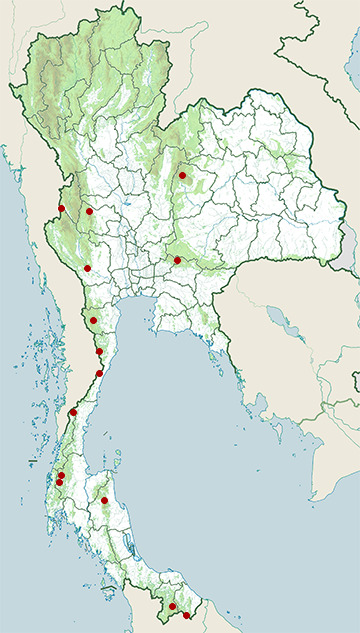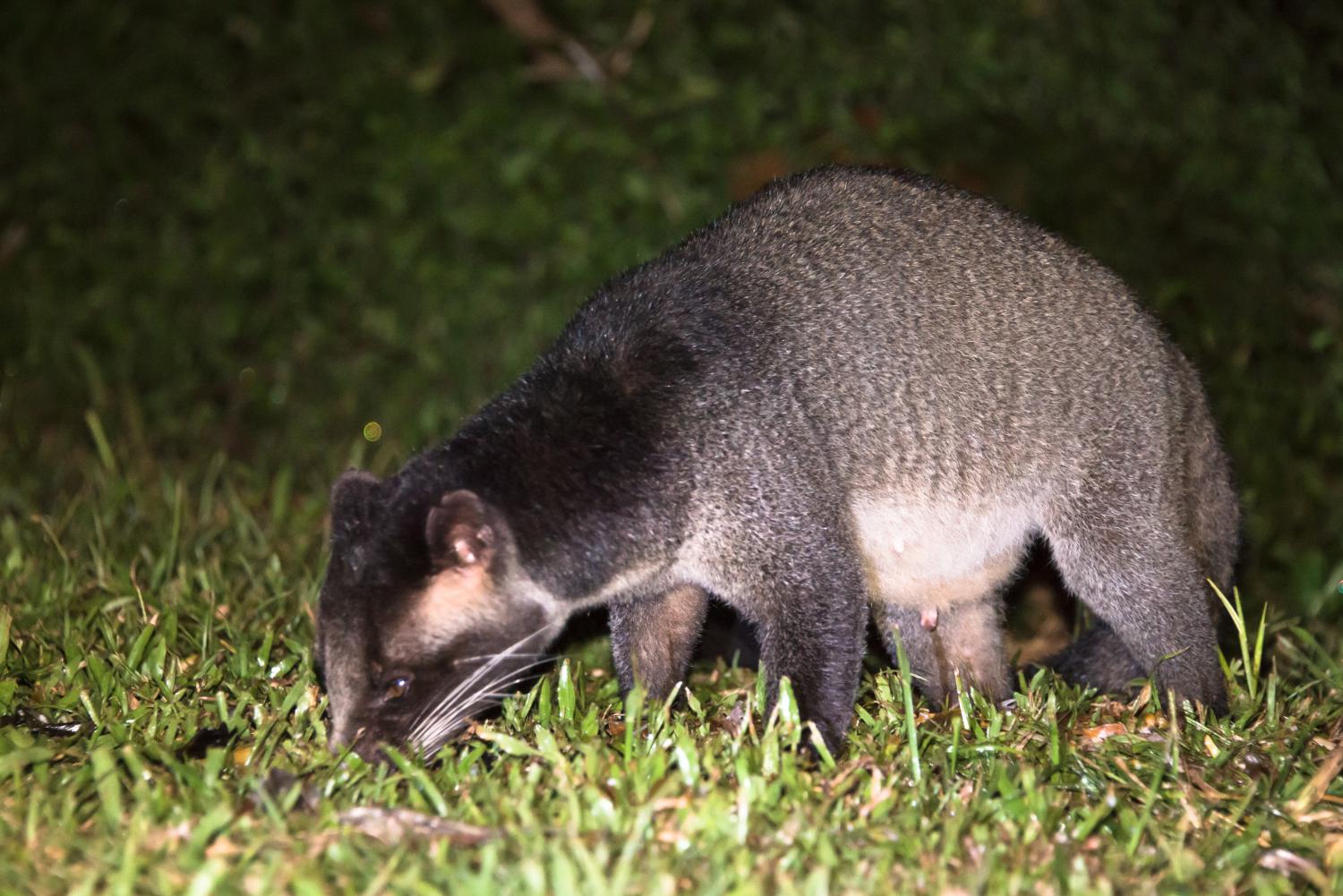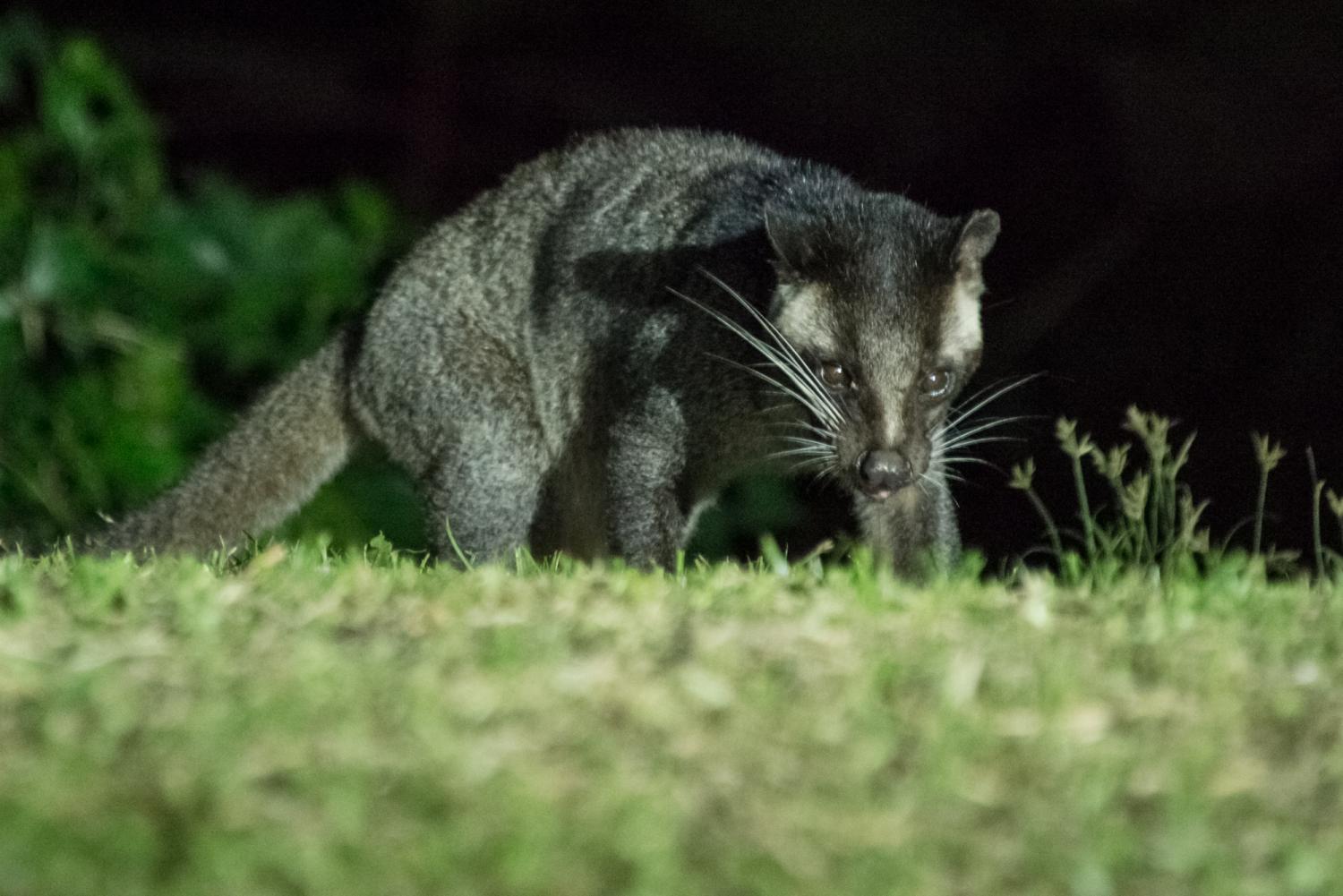Species of Thailand
Masked palm civet
Paguma larvata
(Charles Hamilton Smith, 1827)
In Thai: อีเห็นเครือ
The masked palm civet (Paguma larvata), also called the gem-faced civet, is a palm civet species native to the Indian subcontinent and Southeast Asia. It has been listed as least concern on the IUCN Red List since 2008 as it occurs in many protected areas, is tolerant to some degree of habitat modification, and widely distributed with presumed large populations that are unlikely to be declining.
The genus Paguma was first named and described by John Edward Gray in 1831. All described forms are regarded as a single species.
In 2003, masked palm civets at a wildlife market in China were found to have been infected with the severe acute respiratory syndrome coronavirus.
Characteristics
In morphology the masked palm civet resembles other palm civets, but does not have spots or stripes. Its fur is reddish to grey, and it has a black and white facial mask. Its tail is more than two-thirds the length of head and body. It has three mammae.
The mask consists of a prominent white stripe stretching from nose to forehead (sometimes extends farther but has greatly reduced thickness) that halves a black mask that extends laterally to the far edges of the cheeks and caudally up the forehead, past the ears, and down the back of the neck before stopping just under the shoulder blades. The eyes are surrounded by white fur that can vary from faint, incomplete outlines to well-defined . The lips, chin, and throat are white. In some, white stripes of fur, comparable to sideburns on humans due to shape and location, curve up from the throat. These curves vary in thickness and have ends that terminate either in small blotches at the ear base or large blotches that surround the base of both darkly furred ears.
No matter which coat it sports, masked palm civet's feet are always dark, often black, and the melanism usually extends partway up the legs in varying distances and intensities depending on the individual. The end of a masked palm civet's tail is sometimes darker than the majority of its coat. This difference in pigmentation can vary from a few shades darker than its coat to solid black and can cover a fourth to half of the tail.
The main body varies from 51 to 76 cm (20 to 28 in) in length, to which is added a tail of 51 to 63 cm (20 to 25 in). It weighs between 3.6 and 6 kg (8 and 13.2 lb).
Distribution and habitat
The masked palm civet is distributed from the northern parts of the Indian subcontinent, especially the Himalayas, ranging eastwards across Bhutan, Bangladesh, Myanmar, Thailand, Peninsular Malaysia, Laos, Cambodia, Vietnam to China, Borneo, Sumatra, Taiwan, and the Andaman and Nicobar islands. It was introduced to Mainland Japan and Ryukyu Islands.
It has been recorded in both evergreen and deciduous forest, and in disturbed habitat. It also inhabits fragmented forest habitats, albeit at reduced density.
It is also found in Japan, where genetic studies indicate that it is an introduced species with multiple introductions over the centuries, at least two of which are from Taiwan.
Ecology and behaviour
The masked palm civet is a nocturnal solitary predator that is occasionally active during the day.
It is partly arboreal.
When alarmed, the animal sprays a secretion from its anal gland against the predator. The spray is similar in function to that of a skunk, and its conspicuousness serves to deter other predators.
Feeding and diet
The masked palm civet is an omnivore feeding on rats and birds as well as on fruit such as figs, mangoes, bananas, and leaves. Scat analysis indicates that they also eat mollusks, arthropods, bark and to a lesser extent snakes and frogs. The composition of the diet varies between seasons and sites.
Reproduction
Masked palm civets are polyestrous and their mating behavior is promiscuous. There are two breeding seasons per year. The female bears up to four young. Masked palm civets are known to reach 15 years of age in captivity.
Copulation in masked palm civets can last for more than 30 minutes. Upon completion of copulation, males leave a copulation plug in the female's vaginal tract. The young grow to the size of an adult in about three months.
Threats
The major threats for the masked palm civet are continued habitat destruction and hunting for bushmeat. It is widely offered in restaurants in southern China and is also eaten in Vietnam.
Conservation
Paguma larvata is protected in Malaysia and China, but not Thailand and Nepal. The population of India is listed on CITES Appendix III.
Connection with SARS
In May 2003, the SARS virus was isolated in several masked palm civets found in a wildlife market in Guangdong, China. Evidence of virus infection was also detected in other animals including a raccoon dog, and in humans working at the same market.
In 2006, scientists from the Chinese Centre for Disease Control and Prevention of the University of Hong Kong and the Guangzhou Centre for Disease Control and Prevention established a direct genetic link between the SARS coronavirus appearing in civets and humans, bearing out claims that the disease had jumped across species.
This article uses material from Wikipedia released under the Creative Commons Attribution-Share-Alike Licence 3.0. Eventual photos shown in this page may or may not be from Wikipedia, please see the license details for photos in photo by-lines.
Scientific classification
- Kingdom
- Animalia
- Phylum
- Chordata
- Class
- Mammalia
- Order
- Carnivora
- Family
- Viverridae
- Genus
- Paguma
- Species
- Paguma larvata
Common names
- German: Larvenroller
- English:
- Gem-faced civet
- Himalayan palm civet
- Masked palm civet
- Spanish:
- Civeta de las palmeras enmascarada
- Paguma
- French:
- Civette palmiste à masque
- Pagume
- Civette masquée
- Italian: Civetta delle palme mascherata
- Dutch: Witsnorpalmroller
- Russian: Гимала́йская циве́та
- Swedish: Maskpalmmård
- Thai: อีเห็นเครือ
Conservation status

Least Concern (IUCN3.1)
Photos
Please help us review our species pages if wrong photos are used or any other details in the page is wrong. We can be reached via our contact us page.
Range Map

- Bang Lang National Park
- Hala-Bala Wildlife Sanctuary
- Huai Kha Khaeng Wildlife Sanctuary
- Huai Yang Waterfall National Park
- Kaeng Krachan National Park
- Khao Luang National Park
- Khao Sok National Park
- Khao Yai National Park
- Khlong Saeng Wildlife Sanctuary
- Kui Buri National Park
- Phu Khiao Wildlife Sanctuary
- Sadeth Naikrom - Krom Luang Wildlife Sanctuary
- Salak Pra Wildlife Sanctuary
- Thung Yai Naresuan Wildlife Sanctuary


